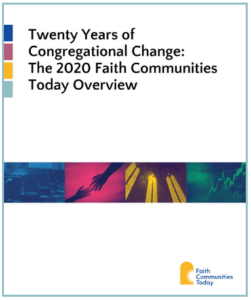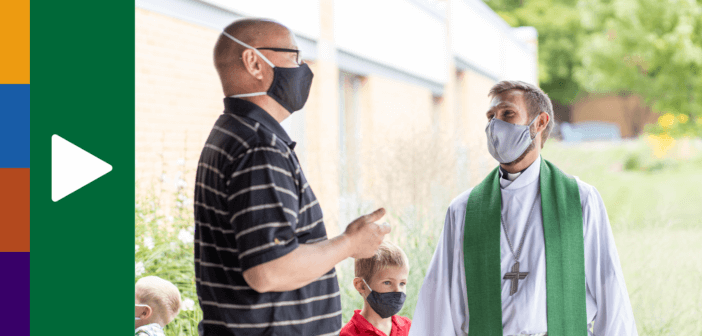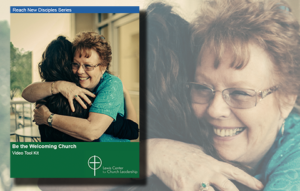
How has the pandemic shaped the vitality and resiliency of congregations? Did it really prompt large numbers of pastors to leave ministry? Scott Thumma shares insights from ongoing research on the pandemic’s impact on congregational life and health.
Listen on Apple Podcasts | Stitcher | Google Podcasts | Spotify
>>> Watch on YouTube
- Transcript — Click or Tap to Read
-
Announcer: Leading Ideas Talks is brought to you by the Lewis Center for Church Leadership of Wesley Theological Seminary in Washington, DC. Subscribe free to our weekly e-newsletter, Leading Ideas, at churchleadership.com/leadingideas.
Leading ideas Talks is also brought to you by Be the Welcoming Church. With this engaging video resource, you’ll learn how your church can make visitors feel truly welcome and comfortable through best practices for developing welcoming worship, church buildings, congregations, and websites. Learn more about Be the Welcoming Church and watch sample videos at churchleadership.com/bethewelcomingchurch.
How has the pandemic shaped the vitality and resiliency of congregations? Did it really prompt large numbers of pastors to leave ministry? Scott Thumma shares insights from ongoing research on the pandemic’s impact on congregational life and health.
Douglas Powe: Welcome to Leading Ideas Talks, a podcast featuring thought leaders and innovative practitioners. I am Douglas Powe, the director of the Lewis Center and your host for this talk. Joining me is Dr. Scott Thumma who is the principal investigator for the Exploring the Pandemic Impact on Congregations study and Professor of Religion at Hartford International. Our focus for this podcast is early insights from the project on the impact on the pandemic. Scott, I’m so grateful you’re joining us today and looking forward to this conversation about your work.
Scott Thumma: Oh, it’s wonderful to be here, Douglas. I appreciate talking with your audience and giving you whatever insight that I have about this strange situation that we’re living in.
Douglas Powe: Absolutely. A strange situation. Let’s begin by just having you share a little bit about the project and the work that you’re doing because we all know of course, as we’re living through this pandemic, that it certainly has created an impact. And you’re actually studying that impact. So, can you share a little bit about what you’re doing?
Scott Thumma: Sure. I was on sabbatical when the pandemic started, and I quickly realized as a sociologist of religion that this was going to have a pretty profound effect on congregations. And it did immediately. But the longer the pandemic looked like it was going to go on, the more profound I thought the challenges were going to be. We were in the midst of working on our Faith Communities Today National Survey for 2020 in which we eventually collected 15,000 responses from congregations. Most of that was just prior to the pandemic, so we’ve taken that as kind of a baseline measure.
I proposed to the Lilly Endowment a larger survey to look at how congregations were dealing with the pandemic but mostly to look at the changes that were going to be happening over time. So, what we put together was a five-year project that had key informant survey data attached to it across those five years. We have a longitudinal panel component. We also are doing case studies on about 100 congregations in eight different locations around the country. Then, mostly in 2023 and 2024, we’re going to do a very large attender survey. We’ll be asking people in the pews how they weathered the pandemic but also how they’re thinking about responding to the challenges to their congregations as they sit in the pews and volunteer and such. What we’re trying to do is capture as much data around both what congregations did during the pandemic but then also what they look like in 2023, 2024, and 2025 to see which things really don’t look the same as they did in the past. So, we’ll see how it goes. Thus far, it’s a challenging time for sure.
Douglas Powe: I thank you for the overview. And I just want to pick up where you ended up with the challenging time. I know you’re early into the project, but how do you think faith leaders have fared? What is the toll you believe that the pandemic has taken on faith leaders just from your early conversations?
Scott Thumma: Well, in our first survey, which we did last summer, we asked the question “Was 2020 the worst year of your ministry?” About 65% said they had thought that at some point in 2020, which leads me to wonder how rough was it for the other group of people? You know, maybe it was their first year of ministry or, as one of my colleagues said, maybe they’re all introverts and they were just happy to not have to have church: “we don’t have to see those people now.” I mean, so clearly every person and every religious leader we talked to talked about being exhausted and worn out. You know they were on creative overload for so long, especially in the congregations of probably 250 attendees or less because they don’t have large staff. Oftentimes much of the creative work rested on the shoulders of a single person, and that person many times works half time. So, it was a challenging time, for sure.
Douglas Powe: Let me follow up with that. You wrote an article, “Is There a Great Resignation Brewing for Pastors?” The connection I want to make here is that there’s been a lot of talk of course about what you just said about the exhaustion, the creativity overload, and all these things taking place for pastors. But in the article, you talk about a nuanced perspective — that it’s not as many people actually leaving ministry as one would believe because there’s been other articles talking about this great pastor resignation. Can you share a little bit about what you wrote and why you’re nuancing a little bit this thought that all the pastors are running for the door?
Scott Thumma: Yes. In the same survey where we asked, “Was this the hardest year?”, we also asked, “Have you seriously considered leaving the ministry?” And we found that about 37% or 38% had said they’d thought that at one point. And that parallels very closely to what the Barna Group research had found, that 38% said that they had thought about leaving the ministry. So, on the surface it looks like there is this massive number, 40% almost, that have been so beaten down by the two years of the pandemic.
But that just didn’t resonate with what I was hearing from clergy. I mean certainly they were tired. They were worn out. They had been up and down in the roller coaster. But it was clear from my conversations that they weren’t ready to get off the ride. You know, they may have thought about it right before they were crashing down at one point, but nevertheless they were still there. So, one of the aspects of our question was how often did you think that? Then we started to look at did they think about it once or twice a day, a few times, often, or very often. When you look at the “fairly often” or “very often” people who are really pondering this, it really drops to 8%, and “very often” really drops to 3%. And that’s true not only for leaving the ministry, but also leaving the church that you’re serving or doubting your call to God. There is a significant number, somewhere between 25% and 35% who have thought it, you know, but the number who are really contemplating it drops down to far less than 10%. For those seriously contemplating it, it is just 3% across the board for all three of those questions, and when we correlated those questions, that 3% is essentially all the same people.
Essentially what it’s saying is that there really are a small percentage of clergy who have kind of given up on the profession. And when you dig even deeper as to why those folks are thinking this fairly often or very often, you really see that they’re in difficult congregations to begin with. All the other measures that we have of conflict or decline over time or challenging financial situations — all of those are active in the congregations that these folks are coming from. So, it’s not just a matter, I think, of clergy giving up because of a difficult situation because of the pandemic, but the pandemic exacerbated what they were already dealing with in the life of these congregations. I think that seems much more realistic to what I’m hearing and what we’re seeing than this massive, great reshuffling and folks resigning. I just think it’s more realistic to the reality.
Learn how your church can make visitors feel truly welcome and comfortable with Be the Welcoming Church. This study includes engaging videos and a Study and Discussion Guide providing scriptures, introductory information, discussion questions, and prayers to structure a group conversation. Be the Welcoming Church may be used for hospitality training or in online or in-person adult classes and groups. Learn more and watch introductory videos now.
Douglas Powe: A couple of follow up questions. The first is one sort of simple. For those who are in that 3%, do you think that — and here I’m asking you to sort of guess — that it’s likely they may have left anyway? It may not have been as quickly. But, given the circumstances of the congregations they pastor and if they weren’t in a system where they could be moved, they probably would have eventually left the ministry anyway.
Scott Thumma: Yes, I do think that’s the case, and that in some sense the pandemic offered them an excuse to make the move now. And honestly that group of 3% look like they wouldn’t be happy even if they transferred somewhere else, right? Even though they said they also thought about leaving their congregation, I don’t think they would have been satisfied just changing playgrounds.
Douglas Powe: That’s interesting and helpful. The other question that strikes me is — and you hinted at this a little bit — you’ve talked about the diversity of congregations in terms of denominations, size, and I’m going to throw race in there. Can you speak a little bit about how that complicates your study of the impact of COVID? You talked about how those under 250 were impacted more significantly than larger congregations. As you start looking at these variables, does it make it hard to really figure out the impact of COVID? Because the reality is some of these congregations would have struggled regardless of COVID. Am I making sense?
Scott Thumma: Yes. It’s challenging, to say the least, in part because obviously the dynamic is still going on. Almost no congregation has recovered in any sort of sense of the word, so it’s still in motion and that makes it difficult. Also, part of our Faith Communities Today project, which has been going on since 2000 and you all have covered wonderfully over the years, really does show that these trends that we’re seeing in the moment around the pandemic were trends that have been developing for the last 20 years. Anytime I do a talk about our pandemic project exploring the pandemic’s impact on congregations, I always begin with a rehearsal of the FACT data — the Faith Communities Today data across time — because what we’re seeing in the pandemic moment is really just an extension of what has already been happening. And some of that has to do with changes around the racial makeup of congregations. Some of it has to do with immigration. A lot of it has to do with this shifting size dynamics in American congregations.
I think the pandemic has obviously stressed all congregations, but it really just intensified some of those patterns, I think, that we saw prior to it. It is hard to tease out which aspects of this are directly due to the pandemic. When you throw in the racial unrest that took place over the last several years and the political unrest that took place over the last several years and the challenges around masking and closures and vaccinations around the pandemic, congregations, social entities, even society as a whole are in a moment of significant turmoil. How much each of those play a part in what we’re seeing is a really interesting question. And I’m hoping that, maybe not in the immediate term but five years down the road, we will have enough data that maybe some smart statisticians will be able to pull some of this apart. But I want to retire by then. No, my main goal with the project is to try to get good, helpful information out to clergy and to congregations as quickly as we can. That’s my main emphasis right now. The real challenging questions come down the road when we have some time to do more analysis.
Douglas Powe: That makes sense. Let me shift a little bit, but it’s still in the same vein. Given what you just said, and we can look at the trajectory going back even 15 or 20 years, how do you think the pandemic has impacted vitality? For the Religious Workforce Project, Tim Snyder, who’s our principal investigator, uses the word resilience. Do you see that congregations really have exhibited resilience and, in some cases, real vitality even in the midst of all the turmoil you just described?
Scott Thumma: Yeah. That was one of the surprising pieces of the first survey that we did, because on the one hand we clearly had a relatively devastating decline in attendance and a significant decline in volunteering, you know, closure of various programs, no fellowship activities that knit people together. But at the same time, you had an institution that is not known for being willing to change — certainly not change rapidly — almost transform itself overnight in terms of how they did worship, how they jumped on online giving and livestreaming.
In those early days when we were interviewing, well, actually a year, almost a year and a half into the pandemic, we are interviewing pastors, and a lot of them were saying “You know, we’re really proud of all that we’ve done.” One of them said, “We beat the pandemic, you know,” because they actually motivated their people to change and to adapt and to innovate. And I would not have ever guessed that. You know, I thought a lot more were just going to close down and wait this out based on the previous decades of research I’ve done on congregations. They are just not known for nimbleness until they get very, very large. It was very clear organizationally that there was a willingness to survive, and that created quite a bit of resilience and innovation.
The other place that in the data there’s just amazing resiliency is around some of those same questions to the clergy, you know, what we talked about already, how many of them had a fleeting thought that “this is terrible” but clearly weren’t giving up. We also had a battery of mental health and physical health and resilience sort of questions, and it looked like there was a little bit of suffering there until I compared it to the average American on some of those same scores. Then clergy actually were looking much healthier than the average person on the street both prior to the pandemic and in the early year of the pandemic. So, it showed that no matter how much clergy were grumbling and worn out and exhausted, they were nevertheless faring well, and I took a lot of hope in that.
You know it’s obviously not over. And clergy have to continue to think about how to adapt and innovate because the world they’re coming out of the pandemic into is not the world that they left prior to the pandemic. In some sense, that moment of creativity and flexibility is not over. But it’s the perfect time for congregations to continue to innovate, because the fallow ground has kind of been broken up for the last two years. Now is a good time to plant some new seeds, I think.
Douglas Powe: Have you discovered in conversations recently that they are still able to do some of the innovation? Or are you finding that individuals are sort of slipping back into what they were doing previous to the impact of the pandemic?
Scott Thumma: That’s the real question: what comes next?
Douglas Powe: Right. Right.
Scott Thumma: I mean, as things continue to evolve, we see both stories, you know, and I think that’s it’s going to be interesting to watch it develop over time. But what we see is that clearly there are at least 30% to 40% of congregations that have taken this to heart and are continuing to try new things in their Sunday school programs, to tweak the worship service so that it’s more adaptable for hybrid worship both virtual and in-person, and creative ways of continuing to do committee meetings — all these sorts of things. Then you see maybe 50% of congregations that are drifting back to old patterns and old habits.
Unfortunately, it does correlate a lot with size, so it’s incredibly easy to understand, right? I mean if you’re a 60-person congregation and you have a three-quarter-time pastor, you know that there are just not the resources and not the energy oftentimes because maybe half those people are over the age of 60 or 65. So, it’s challenging, I think, for a lot of congregations, but some congregations live in areas that weren’t that directly affected by the pandemic. Their social patterns haven’t changed that much as opposed to other more suburban and urban areas where the world is completely different than before.
It will take a number of years, I think, to understand what really shakes out of all of this, but there are probably going to be some winners and some losers. You know, we went into the pandemic knowing full well that there are probably too many congregations, and part of the shifting and the declining size of congregations is that populations have moved around in our country. But you can’t pick up a congregation, the building and everything, and move it, too. So those places that have gained people through migration and immigration don’t have enough congregations. Therefore, they get bigger. And the places where they’ve left, like New England or the central Midwest or small and rural areas, those congregations are increasingly smaller and smaller. The pandemic just kind of amplified that.
Douglas Powe: Well, Scott, as we prepare to close our time together, can you reflect on what you are hoping to share with pastors and congregations in the next 12 months that you think will be able to help them address some of the challenges that you’ve raised? Because of the pandemic but started even before the pandemic. What is it that you’re hoping that you will be able to share with the data you’re collecting?
Scott Thumma: Well, we continue to survey. We just closed out our third pandemic survey. Within the coming weeks, we’ll be putting out two different reports. One is about religious education and how congregations have adapted their Sunday school programs and their adult religious education programs during the pandemic and what kind of creativity they used with those. But then we also have a longer trend of how things are changing over time. We’re trying to map that about every six months, if possible. So those both will be coming out soon. And, as I said, we really want clergy and congregational leaders to get the facts. You know, it’s one thing to kind of hear what’s going on around you, but to see more broadly how congregations are adapting and changing and what practices work best I think will be very helpful for clergy.
We’re also now deep in these case studies. And we’re trying to hear the stories and listen to people — doing interviews, doing focus groups, and making observations within congregations, so we will not just have the sky-high sort of statistical hope picture. But we’re also trying to fill that in with some rich examples and other stories. We’re hoping that in the short run over this next year that will help give clergy and other leaders a better picture of what’s really going on. Oftentimes, you get kind of lost in the details of your own situation and think you’re alone in experiencing some of these things, but we hope that what we find will give clergy some hope and also some answers and resources.
Douglas Powe: Well, Scott, thank you so much. This has been a great conversation. And even though I’ve been following and reading, I still learned some new things about your work, and I look forward to those future reports.
Scott Thumma: Well, thank you Douglas. It’s wonderful talking with you, and if any of your listeners want to be a part of this, they can go to our website at covidreligionresearch.org and volunteer to be a part, have their congregation be a part, and we might even have an honorarium for some of them.
Douglas Powe: Excellent, and we will make sure we link that also when we run the podcast.
Scott Thumma: All right, thank you.
Announcer: Thank you for joining us for Leading Ideas Talks. Don’t forget to subscribe free to our weekly e-newsletter, Leading Ideas, to be notified when new episodes are published. Visit churchleadership.com/leadingideas.
 If your congregation is interested in volunteering to be part of the Exploring the Pandemic Impact on Congregations research project, please visit covidreligionresearch.org.
If your congregation is interested in volunteering to be part of the Exploring the Pandemic Impact on Congregations research project, please visit covidreligionresearch.org.
 Related Resources
Related Resources
-
- How Has COVID-19 Impacted Religious Participation? by Amy Kubichek
- Positioning Your Church for Growth in a New Season of Ministry, an in-depth interview with Tony Morgan
- 4 Truths About Ministry Revealed by the Pandemic by Tom Berlin
- 2020 Faith Communities Today Report





